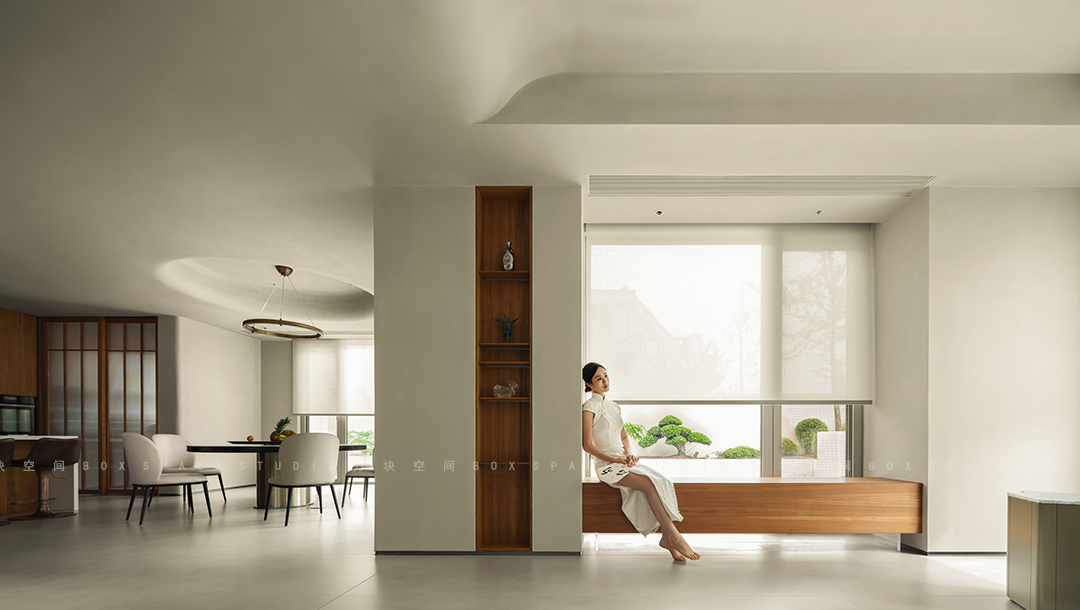Amanenomori Nursery School Aisaka Architects’ Atelier
2016-05-23 20:00
© Shigeo Ogawa
(小川茂雄)


圆形环型结构围绕着土壤、水和绿色,一座两层楼的幼儿园,屋顶露台具有立体和电路式结构,位于富纳巴什市。它的设计理念是为160名儿童提供足够的空间,让他们在大自然中玩耍,也让他们的父母和托儿所工作人员感到安全。
Circular ring shaped structure around the soil, water and green A nursery school of two-story building with rooftop terrace features 3-dimensional and circuit style structure located in Funabashi city. The concept of its design is to provide enough space for 160 children to play around in the nature and also for all their parents and nursery staff to feel safe.
© Shigeo Ogawa
(小川茂雄)


该地点的南部部分用于入口处,其余部分用于托儿所空间。将办公人员、托儿所工作人员和厨师的房间放置在入口和托儿所之间的边界上,既简单又安全。我们设计了圆环形结构,为儿童提供愉快的游乐场,在紧急情况下容易进入逃生路线,在中间有庭院,沿外缘植树,并在中间安装甲板、斜坡、楼梯和桥。外墙外覆实心梯形墙和屋顶,整体结构以其强度达到保护儿童乐趣的目的。它的O形建筑围绕着庭院,外面的走廊带有屋檐以保护天气,这也为成年人提供了舒适和安全的感觉。这种结构可以帮助忙碌的父母在不脱掉鞋子和托儿所工作人员的情况下迅速地把孩子抱起来,以便在另一边互相帮助。
The south quarter of the site is used for entrance walkway, and the rest of the part is for nursery space. Placing rooms for office staff, nursery staff and cooks on the border between entrance and nursery space achieves both simplicity and security. We designed the circular ring shaped structure that provides enjoyable playground for children and easy access to escape route in case of emergency, having the courtyard in the middle, planting trees along the outer edge, and installing the deck, slopes, stairs, and the bridge along the circle between them. Covered with the solid trapezoid-shape wall and roof outside, its overall structure achieves to protect children’s pleasure with its strength. Its O-shaped building surrounding the courtyard with outside corridor with eaves for weather protection also provides comfort and a sense of safety to adults. This structure helps busy parents to drop and pick up their children quickly without taking off shoes and nursery staff to help each other on the other side.
© Shigeo Ogawa
(小川茂雄)


© Shigeo Ogawa
(小川茂雄)


每层楼的外部空间不仅提供室外的开放空间,还提供各种变化,如阳光明媚的地方和阴凉处,屋檐下较高的屋檐和较窄的空间,屋檐、斜坡、山丘和洞室都是由改变地板和屋顶的方向和高度而产生的,这样孩子们在这里度过整整一年就不会感到无聊。半圆形的点式花园,帮助通风,也培育儿童的情感,通过种植绿色的自然中心。从饮食教育的角度,培养儿童对食物的欣赏和兴趣,我们把菜园放在屋顶上,把玻璃墙厨房放在一楼。厨房的地板水平较低,让孩子们望着厨房,同时,它还能观察庭院的交叉形状,以弥补办公室的盲点。
Outer space of each floor provides not just open space outside, but also various changes, such as sunny spot and shade, higher eaves and narrower space under eaves, slopes, hills and cavities produced by changing the direction and the height of floors and roofs, so that children to spend the whole year here do not get bored. The half-circle-shaped spot garden to help ventilation also nurtures children’s affection to the nature by planting greens in the center. From the perspective of dietary education to develop children’s appreciation and interest toward food, we place the vegetable garden on the rooftop and glass-walled kitchen on the first floor. The floor level of kitchen is settled lower to let children look into kitchen, in the same time, it is able to keep an eye on the courtyard in a cross shape to compensate for blind spot from the office.
© Shigeo Ogawa
(小川茂雄)




© Shigeo Ogawa
(小川茂雄)


为了彻底节约能源,我们采用屋檐控制阳光,现场花园改善通风,屋顶隔热屋顶和蔬菜园,地热管加热系统使用地热能,河流和池塘再利用雨水,太阳能电池板生产循环能源。在日常生活中观察这些结构,孩子们可以了解“自然”,包括植物或风雨的现象。
Environmental Plan For thorough energy saving, we adopt the eaves to control sunlight, the spot garden to improve ventilation, the rooftop deck and vegetable garden for heat insulating of rooftop, Earth Tube heating system to use geothermal heat, the river and the pond to reuse the rainwater, and solar panels to produce circulating power. Watching these structures in daily life, children can learn about "the nature" including phenomenon about plants or the wind and rain.
© Shigeo Ogawa
(小川茂雄)


详细设计圆周倒角是为墙壁和栏杆所必需的安全原因,也是为边缘的光线和天窗在建筑的每一个部分,使用它作为一个设计的主题。半圆形的点式花园,通过吸引孩子们对种植在中间的绿色植物的注意,给孩子们带来了对大自然的喜爱。
Detailed Design Round chamfering was done for walls and railings necessary for safety reasons and also for the edge of light and skylight in every part of the building using it as a motif of design. The half-circle-shaped spot garden brings children the affection to the nature by catching their attention to the green planted in the center.


为了让孩子们有机会学习材料的名称,同时感受到它原有的纹理,我们尝试使用“木头为木,钢为钢,石头为石”来保持每一种材料的原始质感。从这个角度来看,我们没有使用原色。相反,我们开发的三维和所谓的“原色样”结构,以提供对比的经验,利用各种空间特征和环境。
Finishing work of Interior and Exterior In order to give children the opportunity to learn the name of materials with feeling its original texture in the same time, we try to use “wood as wood-like, steel as steel-like and stone as stone-like” to keep the original texture of each material. From this perspective, we didn’t use the primary colors. Instead, we exploit the 3-dimensional and so-called “primary color-like” structure to provide contrasting experience using the various spatial features and environment.
© Shigeo Ogawa
(小川茂雄)


“阿曼”是日本汉字中的一种,意为“圆”、“四周围”或“四通八达”,它代表了幼儿园的愿望,让孩子们感受到周围大自然的祝福,同时也代表着环绕森林的圆形建筑特征。我们希望孩子们能在大楼内外周游,感受周围的一切,培养他们的情感和思考能力。
"Amane" “Amane” is one of the Japanese kanji that stands for “round,” “around” or “all-around”, which represents the wish of the nursery school to let children feel the blessing of the all-around nature and also its architectural feature of circular shape around the woods. We wish that children can go around both inside and outside of the building, feeling everything around here, and nourish their sensibility and ability to think.
© Shigeo Ogawa
(小川茂雄)














































Architects Aisaka Architects’ Atelier
Location Funabashi, Chiba Prefecture, Japan
Category Day Care
Architect in Charge Kensuke Aisaka
Area 2051.59 sqm
Project Year 2015
Photographs Shigeo Ogawa































